Staying active late into life is absolutely critical for healthy aging. Older adults and seniors who regularly engage in physical activity (of any form) live longer, happier, healthier lives than their counterparts who are inactive.
The reasons to develop and stick with a workout program are vast, not least of which includes maintaining high human growth hormone (HGH) levels as well as its partner hormone, insulin-like growth factor 1 (IGF-1)
The Health Benefits of Exercise For Adults and Seniors
Before we take a more intense look at HGH and IGF-1 in particular, let’s cover a few broader reasons why regular exercise is essential for adults and seniors.
The science-backed physical benefits of exercise for adults and seniors include:
- First and foremost, the prevention of age-related chronic disease. Researchers have consistently cited the “irrefutable evidence of the effectiveness of regular physical activity in the primary and secondary prevention of several chronic diseases (e.g., cardiovascular disease, diabetes, cancer, hypertension, obesity, depression and osteoporosis) and premature death.” If you could take a single pill, for example, to prevent all of these illnesses, you would, right? Exercise is that pill – it just requires a little extra effort and sweat.
- Strengthening bones. As adults age, their risk of developing osteoporosis – the clinical term for weakening bones associated with the aging process – increases with each year. Women are particularly vulnerable to the risks of osteoporosis, as the chart below indicates.
 The good news is that research backs up the power of exercise to prevent osteoporosis from developing:
The good news is that research backs up the power of exercise to prevent osteoporosis from developing:
“Various types of exercise are effective and safe in preventing the onset of OP. For example, high-intensity progressive resistance training (HiPRT) has been shown to increase vertebral height and femoral neck bone mineral density (BMD), in addition to improving functional performance.”
The science-backed mental/emotional health benefits of exercise for adults and seniors include:
- Improved self-esteem
- Lifted mood
- Reduced anxiety
- Alleviated depression
- Better reaction to stress
- Optimized cognitive function*
Particularly for older adults and seniors, the beneficial impacts of exercise for maintaining cognitive function cannot be exaggerated:
“Advancing age is associated with a decrease in cognitive function that ultimately affects quality of life… Exercise may be one strategy to prevent or delay cognitive decline.”
- Combatting age-related muscle loss (sarcopenia). Defined as “a loss of muscle mass and function in the elderly that reduces mobility, diminishes quality of life, and can lead to fall-related injuries, which require costly hospitalization and extended rehabilitation,” sarcopenia is a serious threat to quality of life in the elderly. Regular exercise, particularly resistance training such as weightlifting, is proven to increase and maintain muscle mass and stave off the effects of sarcopenia.
Exercise Is Proven to Substantially Increase HGH Release
Alongside dietary changes and getting plenty of sleep, adequate exercise is one of the best natural interventions to increase HGH production in the pituitary gland:
“Exercise is a potent physiological stimulus for growth hormone (GH) secretion, and both aerobic and resistance exercise result in significant, acute increases in GH secretion. Contrary to previous suggestions… recent research from our laboratory has shown that regardless of age or gender, there is a linear relationship between the magnitude of the acute increase in GH release and exercise intensity.”
This phenomenon is called the exercise-induced growth hormone response (EIGR):
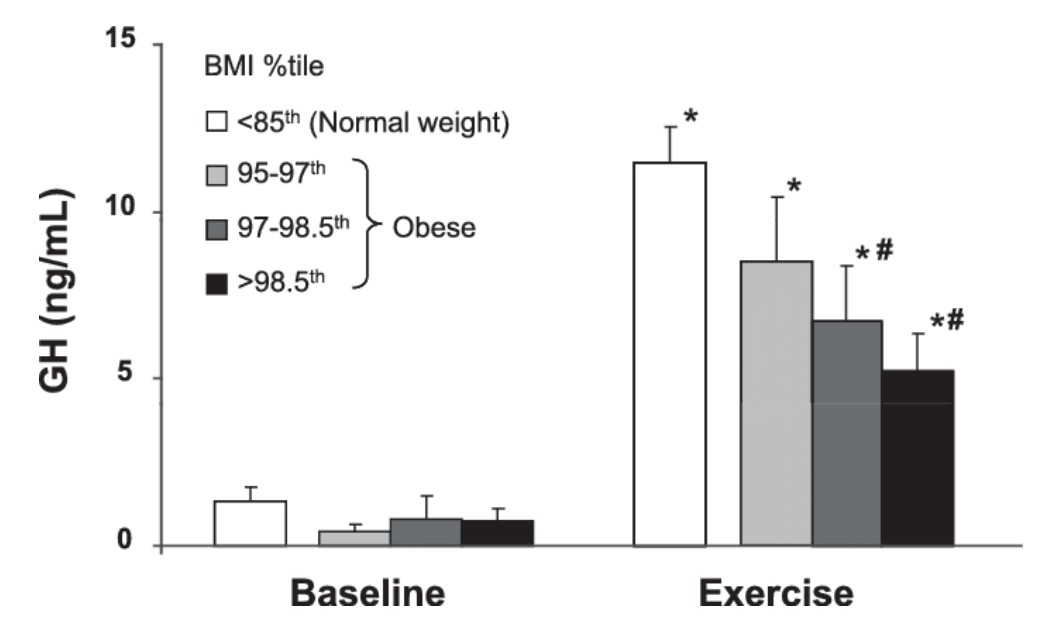 “The exercise-induced growth hormone response (EIGR) is well recognised and although the exact mechanisms remain elusive, a number of candidates have been implicated. These include neural input, direct stimulation by catecholamines, lactate and or nitric oxide, and changes in acid-base balance.”
“The exercise-induced growth hormone response (EIGR) is well recognised and although the exact mechanisms remain elusive, a number of candidates have been implicated. These include neural input, direct stimulation by catecholamines, lactate and or nitric oxide, and changes in acid-base balance.”
Essentially, the neurological and hormonal (biochemical) shifts that occur during exercise (especially intense types) trigger EIGR and greatly increase the amount of HGH pumped into the bloodstream through the pituitary gland.
The chart below published in the Journal of Applied Physiology demonstrates the enormous impact that exercise can have on HGH levels:
Now, let’s get into the ideal exercises you can incorporate into your regular routine to maximize your own HGH levels by way of the mechanisms described above.
Best Exercises For Boosting HGH Levels in Adults
The wide world of exercise now offers a whole slew of workout options that previous generations may not have had access to. Any form of exercise will offer benefits in terms of boosted HGH levels, but some are more effective than others.
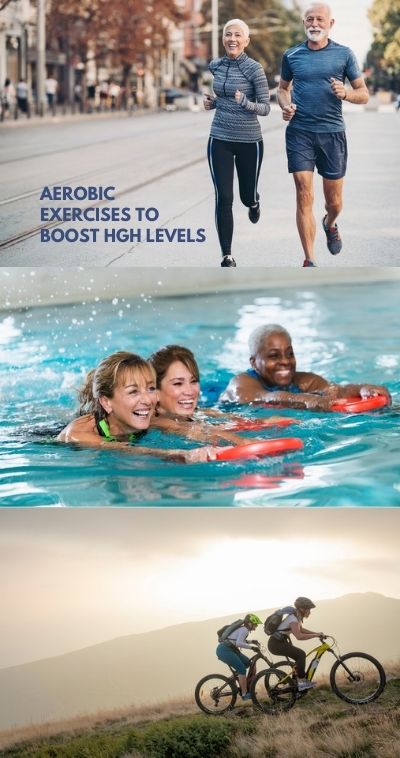
Here, we’ll run down the absolute best exercises for upping your natural HGH levels for more energy, better body composition, and improved mental health.
Aerobic Exercises for Increasing HGH Release
In its simplest definition – as offered by the American College of Sports Medicine (ACSM) – the term aerobic exercise refers to “any activity that uses large muscle groups, can be maintained continuously and is rhythmic in nature. As the name implies, muscle groups activated by this type of exercise rely on aerobic metabolism to extract energy in the form of adenosine triphosphate (ATP) from amino acids, carbohydrates and fatty acids.”
Popular examples of aerobic exercise that induce HGH release include:
- Jogging.
- Sprints.
- Walking.
- Cycling.
- Burpees.
Water aerobics, as the name implies, involves aerobic activities performed in the water. Some examples of water aerobics are:
- Swimming.
- Flutter kicking.
- Standing water push-ups.
- Aqua jogging.
Many older adults prefer water aerobics because they are easier on the joints, which can become susceptible to chronic pain throughout the aging process (see later section for more detail on how to avoid exercise-related pain later into life).
Bonus: as we mentioned earlier, the performance of aerobic exercise hinges on optimal utilization of adenosine triphosphate (ATP), the primary energy currency of many cells. When you increase your HGH levels through exercise, this, in turn, has a beneficial impact on ATP levels (just another reason to add regular cardio to your daily regimen):
“The 4-fold increase in plasma GH caused elevations in plasma IGF-I, insulin, glucose, and free fatty acids and a shift in fuel selection, with less carbohydrate (-69%) and leucine (-43%) oxidation and 29% more fat oxidation. Muscle mitochondrial ATP production rate and citrate synthase activity were increased 16-35% in response to GH.”
*It’s critical to note here that, when pushing more HGH into the blood supply is the goal, intensity trumps duration – meaning, it’s much more effective to exert yourself hard in intervals (for example, in sprints) than to maintain a low level of output for long periods (for example, in walking).
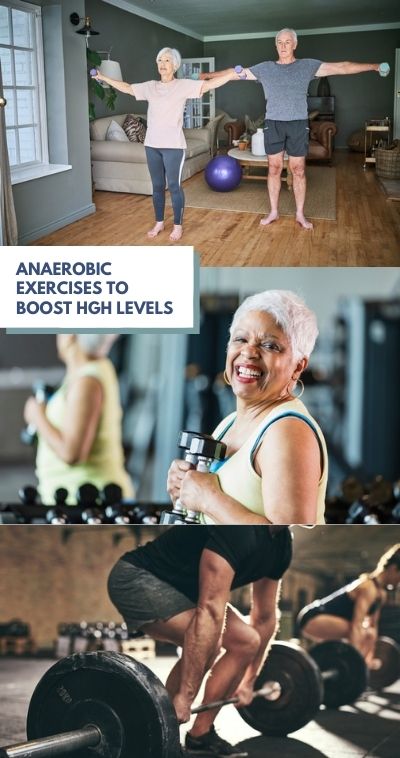
Plan your aerobic workout accordingly.
Anaerobic Strength-Building Exercises for Increasing HGH Release
Resistance training, alternatively known as strength-building, is a particularly powerful group of exercise programs for supercharging endogenous HGH production.
Undeniably, due to the unique demands placed on the body and the physiological ramifications, anaerobic (meaning “without oxygen”) resistance training is ideal if higher HGH levels are your primary goal.
Examples of highly effective resistance training programs for raising HGH include:
- Weightlifting.
- High-intensity interval training (HIIT)
- Circuit training.
- Medicine balls.
- Kettlebells.
If you’re just getting started on your exercise program, here is a decent beginner’s guide to a high-quality, HGH-boosting resistance training session:
- Flat barbell bench press (3 sets of 10)
- Barbell squats (3 sets of 10)
- Barbell deadlift (3 sets of 10)
- Dumbbell bicep curls (3 sets of 10)
The weights used should be heavy enough that, beginning around the 8th repetition in a 10-repetition set, you should feel a “burning” sensation that subsides after you finish your set (ensure you take 2-3 minutes of rest before beginning the next set).
This “burn” – not to be confused with pain caused by injury — is a “good pain” that signals a buildup of lactic acid, a sure sign that you are engaged in the right type of activity to increase HGH levels.
Alternative Exercises to Boost HGH Levels
If the options we’ve explored so far don’t tickle your fancy, here are a few popular alternatives to the more conventional exercise programs discussed above that can help get your HGH levels where they need to be:
 Pilates. This century-old practice focuses on improving breathing, posture, flexibility, and core muscle strength. One of the attractive features of Pilates is its flexibility in terms of adapting your routine to meet your individual goals, with proponents noting that “exercises can be adapted to provide either gentle strength training for rehabilitation or a strenuous workout vigorous enough to challenge skilled athletes.”
Pilates. This century-old practice focuses on improving breathing, posture, flexibility, and core muscle strength. One of the attractive features of Pilates is its flexibility in terms of adapting your routine to meet your individual goals, with proponents noting that “exercises can be adapted to provide either gentle strength training for rehabilitation or a strenuous workout vigorous enough to challenge skilled athletes.”
- Resistance band training. As an ideal alternative for many to weightlifting, which carries a greater risk of injury and also requires additional equipment, resistance band training can be performed virtually anywhere. Best of all, the only required piece of equipment is an affordable resistance band that you can fit underneath your bed. Several types of effective movement for maintaining muscle and improving flexibility can be performed with resistance bands, including leg press, triceps press, bicep curls, and band pull apart.
- Yoga. The ancient practice of yoga offers a range of benefits that is truly unrivaled: “yogic practices enhance muscular strength and body flexibility, promote and improve respiratory and cardiovascular function, promote recovery from and treatment of addiction, reduce stress, anxiety, depression, and chronic pain, improve sleep patterns, and enhance overall well-being.”
In fact, if you could only choose one form of exercise to regularly practice deep into life, yoga might be your best option, given the multitude of proven health benefits for older adults, including keeping joints, tendons, and ligaments supple and injury-free.
*For older adults with limited mobility, chair yoga is an ideal alternative to reap the benefits of traditional yoga. Many of the movements and positions are the same, but can be performed comfortably while seated rather than requiring a mat on the floor.
Potentially Dangerous Exercises to Avoid After 40
Depending on your individual level of fitness, medical history, and any underlying health issues, some exercises might be better left undone after 40.
Here are a few of the most common types of dangerous activities for some (not all) older adults:
- Running/jogging. For some, running or jogging will present no issue – in fact, it’s not unheard of for 70+-year-olds to run in marathons. However for others, the repeated impacts on the joints (especially the knees) can worsen or aggravate previous injuries or conditions.
If your joints are sensitive to the “pounding” activity of running but you still want to gain the cardiovascular benefits of this great aerobic exercise, consider swapping your running routine for bicycling or swimming, each of which deliver similar results without the pressure and potential damage to your joints, especially your knees.
- Heavy weightlifting. Certain weightlifting maneuvers such as deadlift and squat carry a risk of injury, especially when the lifter is attempting a weight that is on the threshold of his or her capabilities. Accordingly, you may want to opt for lighter weights with higher reps – aiming for somewhere in the 15-20 max rep range to avoid unnecessary risk of injury while still reaping the health benefits of the exercise
- Bikram yoga. Often called “hot yoga,” Bikram yoga calls for sessions in extremely hot sauna-like environments that pull out enormous quantities of sweat. While Bikram yoga can be amazingly beneficial, older adults should be wary of its dangers in the form of dehydration and/or heat stroke.
- Stair running. While stair running is a potentially superb enhancement of a cardio routine by adding an extra layer of gravitational resistance, it can be a dangerous (and even deadly) activity for aging adults who might suffer from balance issues.
The Importance of Maintaining High HGH Levels in Adulthood For Optimal Health
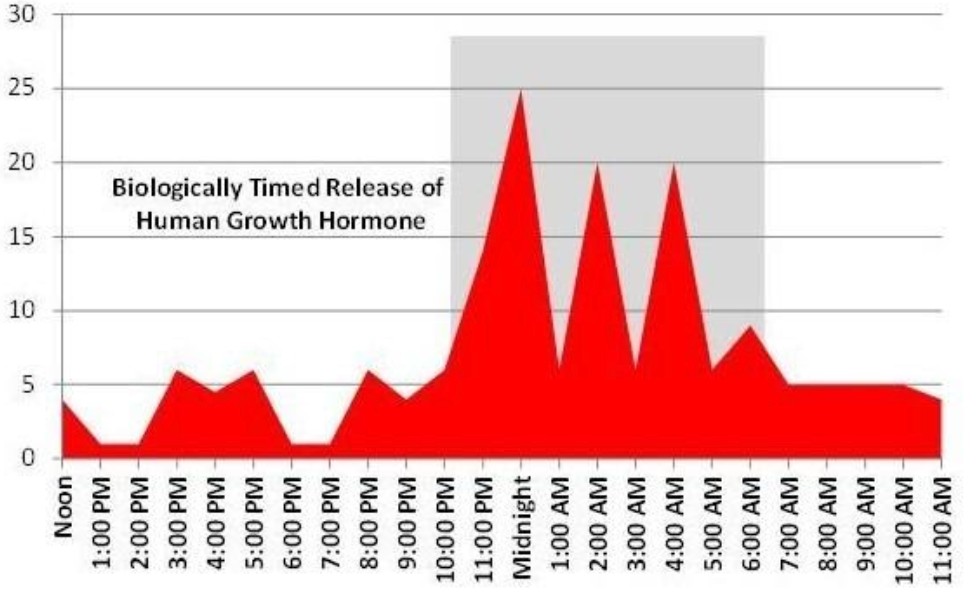 Now that we’ve covered the sweeping health benefits of exercise for aging adults in general, let’s hone in on the benefits of exercise for supporting healthy HGH and IGF-1 levels.
Now that we’ve covered the sweeping health benefits of exercise for aging adults in general, let’s hone in on the benefits of exercise for supporting healthy HGH and IGF-1 levels.
Human growth hormone (HGH) is one of the roughly 50 hormones (chemical messengers) that regulate physiological processes in the human body. The pituitary gland, a small pea-sized structure in the brain, produces HGH to be released throughout the 24-hour-cycle in pulsatile secretions, following the body’s natural “circadian rhythm” cycle.
As you can see depicted in the chart above, the maximum concentrations of HGH are released at night during sleep. Accordingly, this is the reason that sleep deprivation (an inadequate amount of sleep) is associated with low HGH levels and even HGH deficiency while individuals who get 7-9 hours of quality sleep each night tend to enjoy higher HGH levels.
Following the pituitary gland’s secretion of HGH in the bloodstream, the hormone journeys through the body until it reaches the liver, where it signals for the release of a closely related pro-growth hormone, insulin-like growth factor-1 (IGF-1).
Together, IGF-1 and HGH perform several critical functions, many of which pertain directly to physical and athletic performance:
- Regulation of muscle mass
- Nutrient metabolism
- Protein synthesis
- Reducing visceral fat (“belly fat”) accumulation
 WordPreventing atherosclerosis (the buildup of plaque in the blood vessels that can lead to cardiovascular disease)
WordPreventing atherosclerosis (the buildup of plaque in the blood vessels that can lead to cardiovascular disease)- Improving cardiovascular function
How Healthy HGH Levels Support the Benefits of Exercise
Through the hormone’s impact on metabolism (energy-burning), higher HGH levels, in turn, help facilitate higher rates of caloric burning during exercise to achieve greater weight-loss results in overweight or obese individuals.
In combination, HGH and its partner hormone discussed above (IGF-1) boost metabolism significantly as demonstrated in clinical research:
“Growth hormone (GH) stimulates the production of insulin-like growth factor 1 in most tissues, and together GH and insulin-like growth factor 1 exert powerful collective actions on fat, protein and glucose metabolism.”
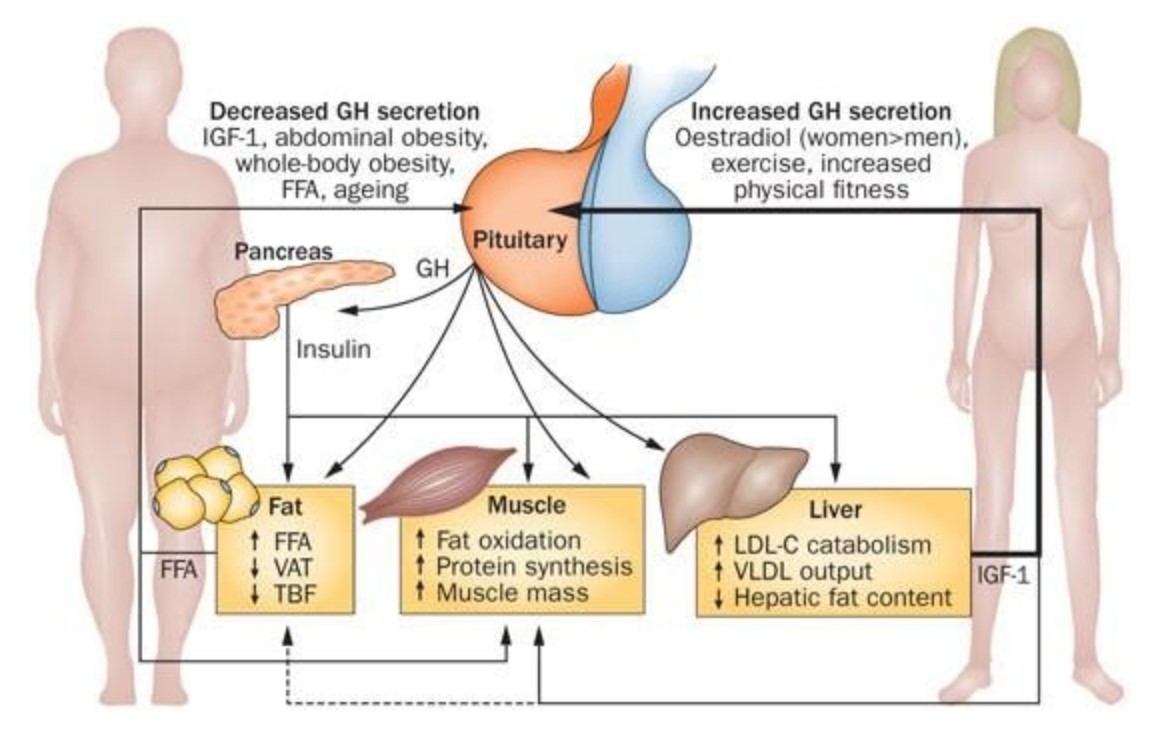
Clinical trials assessing the effects of GH treatment in patients with obesity have shown consistent reductions in total adipose tissue mass, in particular abdominal and visceral adipose tissue depots.
HGH deficiency, therefore, is one possible explanation for why older and aging adults often fail to reach a healthy weight, even with diet and lifestyle interventions such as increased physical activity.
In this way, HGH deficiency and obesity can exert a spiral effect: lower HGH levels make exercise less effective in terms of achieving greater fitness, while less exercise reduces the production of HGH.
In cases such as these, a combination of a regular exercise regimen and, possibly, hormone replacement therapy (HRT) with recombinant HGH (somatropin) may be advised to achieve the healthcare goals of the patient.
How to Stay Motivated For Movement After 40
Whether you are 6 or 60 years old, one of the hardest parts of initiating and committing to a routine is motivation – that initial drive to “get up and go.”
Here are a few ways that you, as an older adult, can commit yourself to a health-boosting exercise regimen and stick to it:
- Set specific goals in writing. Research shows that when you write down specific goals – i.e., “complete a 5K walk,” “150 weekly minutes of aerobic activity” – you are much likelier to follow through.
- Join a workout group or find a buddy. Studies show that people tend to stay committed to any task – whether exercising or a work assignment – if they have someone to hold them accountable for showing up and putting in the effort.
- Create a list of all of the benefits of exercise – improved cognition and mood, reduced risk of injury, greater physical strength, optimized hormonal balance – and keep it displayed in a prominent location like the fridge as an extra motivator on days you might not want to hit the gym.
- Keep it fun. We’ve outlined numerous (dozens) of exercises here that you can choose from – so why not pick one that’s fun and effective at the same time?

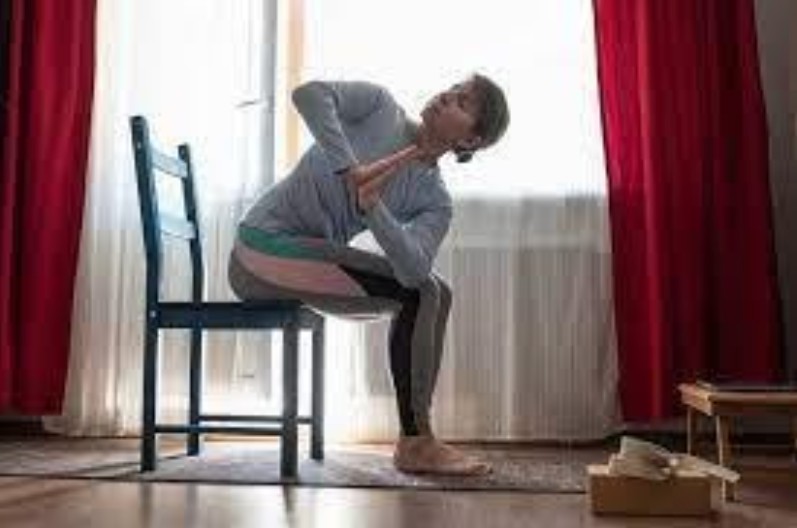
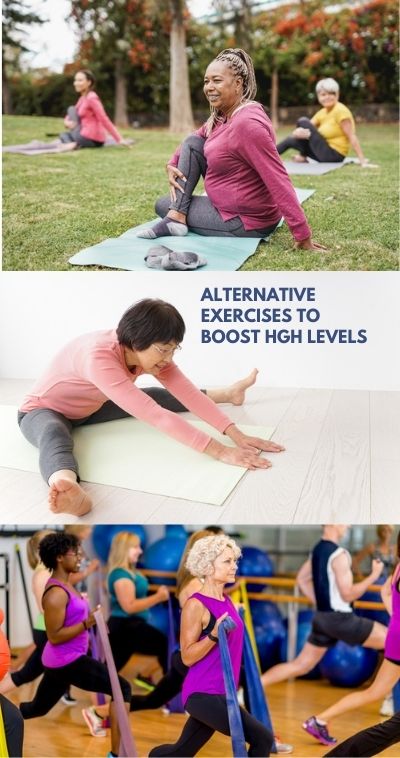 Pilates. This century-old practice focuses on improving breathing, posture, flexibility, and core muscle strength. One of the attractive features of Pilates is its
Pilates. This century-old practice focuses on improving breathing, posture, flexibility, and core muscle strength. One of the attractive features of Pilates is its 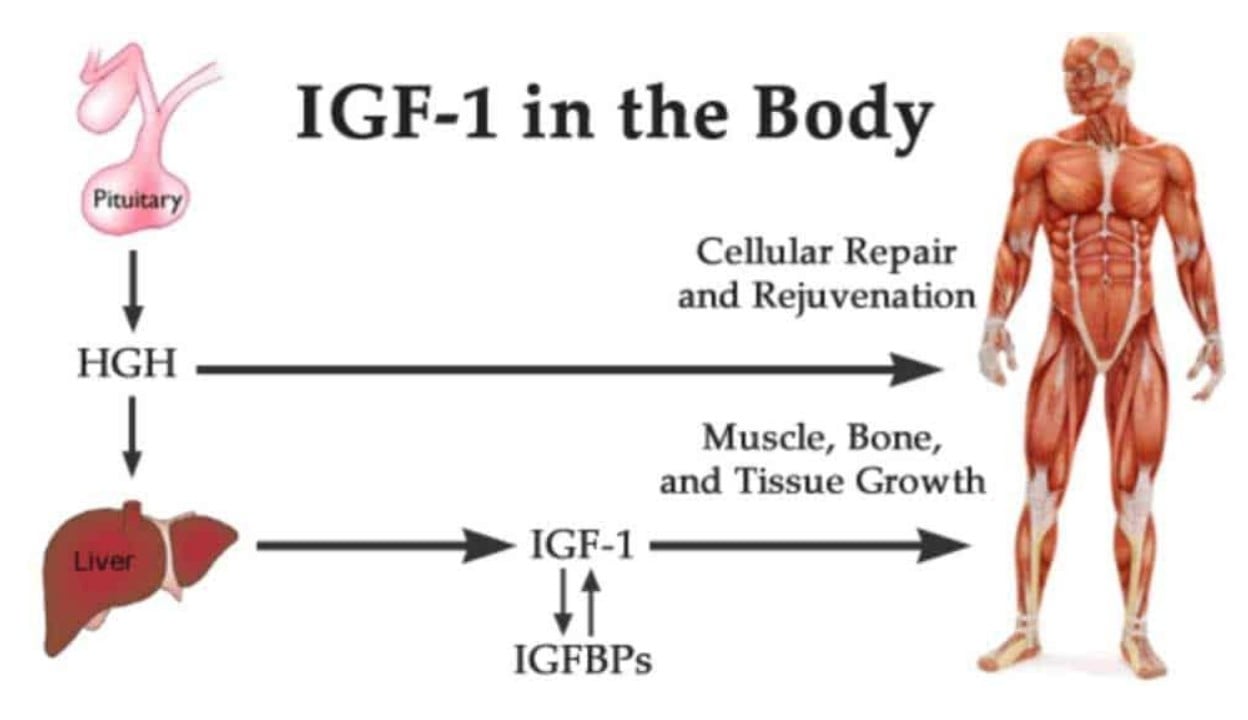 WordPreventing atherosclerosis (the buildup of plaque in the blood vessels that can lead to cardiovascular disease)
WordPreventing atherosclerosis (the buildup of plaque in the blood vessels that can lead to cardiovascular disease)